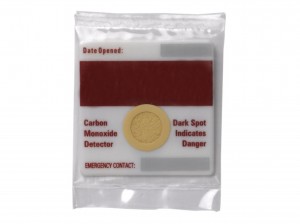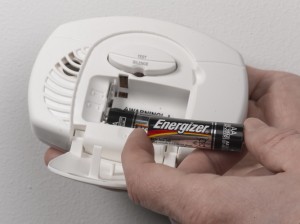Carbon monoxide detector patches
Carbon monoxide (CO) detector patches detect the presence of dangerous levels of CO in the atmosphere, resulting in the circular area in the centre of the detector changing colour. These patches are often seen as an alternative to using mains operated, or, battery operated CO alarms, but this really should NOT be the case, and in the following guide, I’ll explain why.

Carbon monoxide detector patches – will you remember to check the date?
Patch detectors, like the one pictured to the right, certainly work. However, this detection mechanism relies purely on someone actually noticing the change in colour i.e. there is no audible alarm. Also, they have a limited lifespan of a few months, so you have to ask the question as to whether you will definitely remember to change the detector for a new one? Another major design problem is that for reasons of forgetfulness, or maybe idleness in not reading the instructions carefully, many people never bother to fill in the ‘start date’ on the patch, so nobody knows how long the detector has been there!
Yet another issue stems from the fact that nobody really wants to use them in open view as, after all, who wants to look at a plastic patch stuck on a wall in their home. Therefore, I’ve often found them tucked around a corner, or positioned where you need to make an effort to check them, which makes their installation fairly pointless.
Just to underline the need for alarms, CO is a poisonous gas that can quickly kill, through suffocation, if it rises to harmful levels in your home. Detection is a big problem as CO is a gas that is completely odourless and colourless, so you cannot notice it’s presence without some sort of detector or alarm. The reason CO can rise to dangerous levels in your home is because most of us have fuel-burning appliances, such as boilers, cookers and water heaters, and CO is produced when these appliances malfunction and/or are starved of the necessary amount of fresh air to make them function correctly.

Always have battery operated, or mains operated CO alarms fitted. Never rely solely on patch detectors.
So if you have any fuel burning appliance in your home, along with regular servicing of these appliances, you must also have CO alarms fitted, rather than rely on someone seeing a change in colour on a detector patch.
I have no problem with people using them as a back-up or a complement to audible alarms, but if you choose patches alone, I would suggest that your home is protected only marginally more than having no protection at all.
For further information on how to fit a CO alarm, please check out my guide which is listed in the related posts further down this page. Fitting a carbon monoxide alarm really is a very simple task – do it today!
